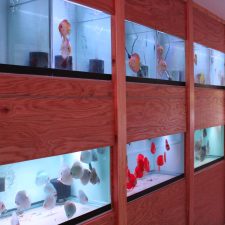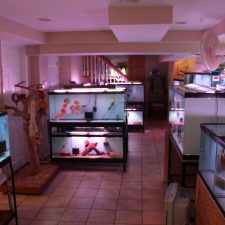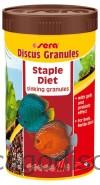Care and Feeding
Frequently Asked Questions
 What is the appropriate water temperature for discus fish? The ideal water temperature for discus is between 82 and 86 degrees Fahrenheit. The water we keep our discus in is 84 degrees Fahrenheit. When replacing the water, make sure the new water is at least one degree warmer than what is already in the tank.
What is the appropriate water temperature for discus fish? The ideal water temperature for discus is between 82 and 86 degrees Fahrenheit. The water we keep our discus in is 84 degrees Fahrenheit. When replacing the water, make sure the new water is at least one degree warmer than what is already in the tank.
How often and how much should I change the water? We recommend changing their water at least twice a week. Gravel vacuum the substrate, wipe out the aquarium tank and replace at least half of their water. Should you have over the recommended number of discus fish in the same tank, then you should change the water more often.
How many discus can I keep in my aquarium? The general rule is roughly 10 gallons of water per one adult discus. A 215-gallon tank can accommodate 22 discus, while a 55-gallon tank can hold five or six. Unless you plan on changing the water with greater frequency, then I wouldn’t go over the standard limit as it could be difficult, depending on the size of your fish tank.
How many would you recommend purchasing for one aquarium tank? Discus are school fish and thrive in large groups. If you are new to the discus, start with three to five that are 5 inches or larger. If you want to add more over a period of time, then do so in groups. Also, many hobbyists prefer to one of each variety; however, it’s better if you have two of each. They can hang out together, which will make for a less stressful environment.
I have read that discus prefer low pH levels. What is the recommended pH level? Discus are very adaptable to arrange of pH levels from below six to over eight. While a lower pH (6.0 – 6.5) is recommended for breeding, this isn’t necessary. They will be fine in regular pH tap water. The key is to maintain a consistent pH level.
What is water aging? Sometimes tap water has a different pH level than water that has been sitting in a tank. For example, our fresh tap water is 6.8, but after a few hours, it changes to 7.6 or higher due to the degassing of dissolved CO2. Therefore, aging water is recommended to achieve a stable pH should be used when changing the tank’s water. This also eliminates microbubbles. Remember, pH fluctuations should always be prevented.
What about R/O (reverse osmosis) for water? Unless you plan on breeding, R/O water is not necessary. Discus are fine in tap water. The only exception is rock-hard well water (hardness values in the high teens or 20s, tds 450 or more). You might want to mix RO water with tap water to reduce hardness levels to nine or ten (tds 250 or less).
 Are bare-bottom tanks necessary? Bare bottom tanks are fine. If you have one, I recommend painting the outside bottom to eliminate reflection. Discus do not like it when fish approach them from below, and bottom reflections make them stressful. There is no reason to have a bare bottom other than to make cleaning easier. If you choose to have a substrate, light-colored rounded gravel or heavy flint sand is recommended. It looks better and the discus like it.
Are bare-bottom tanks necessary? Bare bottom tanks are fine. If you have one, I recommend painting the outside bottom to eliminate reflection. Discus do not like it when fish approach them from below, and bottom reflections make them stressful. There is no reason to have a bare bottom other than to make cleaning easier. If you choose to have a substrate, light-colored rounded gravel or heavy flint sand is recommended. It looks better and the discus like it.
Can I add decorations to my tank? Of course! Discus like to interact with their environment and have places to hide. Driftwood is fine if it does not have sharp edges or branches. The best is smooth manzanita driftwood. A planted tank is also fine, and although this requires extra maintenance, it does look beautiful. If you prefer a low-maintenance tank, then you should try using artificial plants.
What would be a good background color for my tank? Many of our customers use aquarium tanks with dark backgrounds. Discus will try to mimic the background. For example, a blue strain (Cobalt, Diamond, Snakeskin, etc.) will turn into a more intense blue against darker backgrounds. This is natural and very attractive. Pigeon Blood discus (Checkerboards, Melons, etc.) might “pepper” against darker backgrounds. They cannot darken entirely, so tiny pepper-colored spots will appear. This doesn’t always happen, but it is a possibility. We recommend a light-blue or similar light-colored background. If you cannot change to something lighter, then lighter-colored substrates and decorations are fine.
Should I quarantine my fish before adding them to the tank? Yes. This link will provide you with some excellent information: Guide written by Paul Villenueve on the Simply Discus Forum. Paul has been an aquarist for over 50 years, and I have tremendous respect for his knowledge and guidance. In this guide, he discusses why discus fish should be quarantined. Please refer to the guide for quarantine procedures and other tips on successful discus keeping.
Here is a quote from Paul: “You need to do this as the new fish may be harboring pathogens they are immune to, but the existing fish are not. Also, the stress of the move may cause problems for the new fish, and you don’t want to transfer this to the existing tank. Finally, if the existing discus harbor pathogens they are resistant to, but the new fish are not, then one risks the potential loss of some new fish. Therefore, all new fish, whether purchased from the same source or not, should be quarantined.”
For those who make an online purchase from Chicago Discus, this is how we recommend you acclimate your discus.
Before receiving your fish, test the pH level in your tank to see what you have.
1. Let the bag float in the tank for 15-20 minutes to adjust the temperature inside the bag with the tank’s temperature. You don’t want to subject the fish to thermal shock.
2. If the pH is lower than 7.0 or you are using R/O water, then you will need to make a few precautions during the acclimation period. Use a regular airline tube with a closed valve attached that can reach from the tank to your bucket. Place a five-gallon bucket underneath the tank. Cut the bag open and gently pour the fish and water into the bucket. Pour a few cups of tank water into the bucket to neutralize the shipping water. Next, start a consistent drip (not a flow) into the bucket. Once the water reaches the top, you are finished. Net the fish out and place them in the tank. The entire process should take less than one hour.
3. If the pH is higher than 7.0 and below 8.3, then place the sealed bag in the tank and wait 20 minutes. Afterward, slice the bag open, empty the shipping water into waste, and slide the fish into the tank.
4. Once your fish are safely in the tank, turn the lights off for the day and let them get used to their new environment. The following morning, turn the lights on and start your normal daily routine.
Josie shows how she acclimated Frank’s Giant Floras in a tank with a pH level above 7.0.
Feeding
The question we are asked most often is, “What do you feed your discus, and how often do you feed them.” Discus enjoy a varied diet consisting of high-quality nutrients, but they also like their goodies. Adult discus are fed twice daily, and younger fish are fed three times a day or more.
For breakfast, start the day with Beefheart Mix, according to our recipe (see video and recipe below).
For lunch, try Sera Discus Granules or other high quality granular or flake food. For a special treat, try Freeze Dried Australian Blackworms.
For supper, we recommend Hikari brand Frozen Bloodworms and Hikari Frozen Brine Shrimp.
Discus typically eat slow and can take an hour or more to finish one meal. Once they have finished, remove all uneaten food so the tank will not become polluted. However, you can leave the bloodworms and brine shrimp overnight and remove the uneaten bits the following morning. Even Discus enjoy late-night snacks.
Basic Beefheart Recipe

This is our classic Basic Beefheart recipe. Quantities can be adjusted according to your needs. The frozen cyclopeeze from the video is no longer available, but feel free to add other ingredients your discus might enjoy.
10 lb trimmed beef heart
1 lb salmon (skin off)
1 lb shelled jumbo shrimp
3/4 lb cooked spinach
1 large ripe banana
2 vitamin/mineral tablets (ground)
2 fish oil capsules (1000 mg, cut open)
2-3 tbsp ground garlic
1/2 cup spirulina flake (binder)
1/2 cup high quality flake food (binder)
Grind the first 5 ingredients together using a meat grinder or food processor.
Mix the remaining ingredients into the ground meat mixture using food processor (low speed).
Pack 1.0-1.5 lb in flat sheets in 1 gallon ziplock bags.
Freeze until ready to use.
When feeding your frozen beefheart mix, chop or mince it into bite-sized morsel. Discus do not like food chunks that are too big for their mouths
Josie shows how we make our Beef Heart recipe at Chicago Discus

